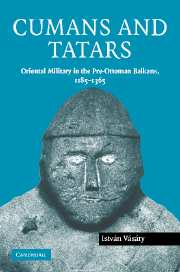 History
HistoryWhile the Cumans were gradually assimilated into eastern European populations, their trace can still be found in placenames as widespread as the city of Kumanovo in the Northeastern part of the Republic of Macedonia, Comăneşti in Romania and Comana in Dobruja.
The Cumans settled in Hungary had their own self-government there in a territory that bore their name, Kunság, that survived until the 19th century. There, the name of the Cumans (Kun) is still preserved in county names such as Bács-Kiskun and Jász-Nagykun-Szolnok and town names such as Kiskunhalas and Kunszentmiklós.
The Cumans were organized into four tribes in Hungary (Kolbasz / Olas in the big Cumania around Karcag, and the other three in the lesser Cumania).
The other Cuman group in Hungary is the paloc group, the name deriving from the Slav Polovetz. They live in the Northern Hungary and current Slovakia and have a specific dialect. Their Cuman origin is not documented as the other two Cuman territory but their name derives from the above word. They have a very special "a" sound close to Turkish "a", unlike Hungarian pronunciation.
Unfortunately, the Cuman language disappeared from Hungary in the 17 century, possibly following the Turkish occupation.
Their 19 century biographer, Gyarfas Istvan in 1870 was on the opinion that they speak Hungarian together with the Iazyges population. Despite this mistake he has the best overview on the subject concerning details of material used. [1]
Also, toponyms of Cuman language origin can be found especially in the Romanian counties of Vaslui and Galaţi, including the names of both counties.
In the countries where the Cumans were assimilated, family surnames derived from the words for "Cuman" (such as coman or kun, "kuman") are not uncommon. Among the people that have such a name are Romanian gymnast Nadia Comăneci, Romanian poet Otilia Coman (Ana Blandiana), contemporary painter Nicolai Comănescu and Romanian football player Gigel Coman. Traces of the Cumans are also the Bulgarian surname Kumanov (feminine Kumanova), its Macedonian variant Kumanovski (feminine Kumanovska) and the widespread Hungarian surname Kun (to further color the topic: this name also was often preferred for Hungarizing Jewish-German name Kohn/Cohen/ so less related to the topic, like for Bela Kun, famous / infamous 1919 Communist revolutionaire / dictator).
The Cumans appear in Russian culture in the The Tale of Igor's Campaign and a set of "Polovtsian Dances" in Alexander Borodin's opera Prince Igor.
Further reading
Cumania
Kipchak
Nomad
Crimean Tatars
Cumania
Pechenegs
Turkic peoples
Mongol invasion of Rus
Tatar invasions
Crimean Karaites, an ethnic group possibly with Cuman origins
Battle of the Stugna River
Battle of Levounion
 Lefthit
Lefthit
No comments:
Post a Comment